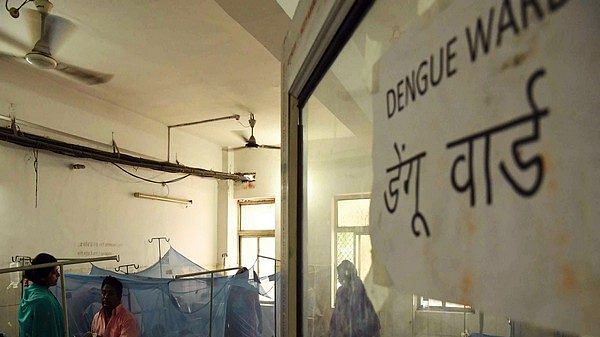New Delhi: Even before the peak dengue season has hit, which are the months of September and October, a huge rise in the number of cases of the vector-borne disease has triggered widespread concern in several parts of the country.
Till June this year, the country recorded 32,091 dengue cases, 75 percent higher than the 18,391 cases recorded in the first six months in 2023, the Union health ministry told Parliament last week.
In a statement, Union Health Secretary Apurva Chandra said that till the month of July, India had seen 50 percent more cases than the corresponding period last year.
“Although dengue cases generally peak in October (after the monsoon), this year’s trend shows that, as of 31 July, 2024, the number of cases is already almost 50 percent higher than at the same time last year,” Chandra said.
The highest number of dengue cases, which can be fatal in severe cases, has been in Kerala, Karnataka, Maharashtra, Tamil Nadu and Andhra Pradesh.
“The alarming numbers have pushed us to hold three inter-ministerial reviews of the outbreak in the country so far, in order to review state-level preparedness and to bolster readiness of public health systems,” a senior ministry official told ThePrint.
Dengue is a viral infection transmitted to humans through the bite of infected mosquitoes, mainly aedes aegypti that also spreads pathogens which cause zika and chikungunya fever.
The World Health Organization (WHO) estimates that about half of the world’s population is now at risk of dengue with an estimated 100 to 400 million infections occurring each year. It is largely reported in tropical and sub-tropical climates, mostly in urban and semi-urban areas but is also happening now in rural parts in countries like India.
Over the last four years, the incidence of the disease has been steadily growing. In 2020, the country saw 44,585 dengue cases which grew to 193,245 in 2021. In 2022, a total of 233,251 dengue cases were registered in various states and the next year, it further increased to 289,235.
Over these years, the country has also registered a significant number of mortalities. In 2020, 56 lives were lost to dengue and in 2021, this number increased to 346. In 2022, 303 dengue patients succumbed to the illness, while 385 died in 2023.
Till June this year, 32 deaths have already been registered.
“This is unfortunate and these lives would have been saved because dengue is a preventable disease,” Dr Neeraj Nischal, additional professor in the department of medicine at the All India Institute of Medical Sciences (AIIMS) Delhi, told ThePrint.
Biomedical scientist Dr Aswhin Kumar, former director of the Indian Council of Medical Research-Vector Control Research Centre (ICMR-VCRC), said the main reasons behind the alarming rise in cases year-on-year were vector mosquito Aedes’ expansion into newer geographical areas under the impact of global warming; lack of targeted surveillance; and limited or no larval source management activities, including treatment with chemical and biological larvicide.
Also read: ‘Udta Tripura’ — HIV cases are soaring in hill state, with youth under 30 worst hit
Urgent policy, community action needed
While many dengue infections are asymptomatic or produce only mild illness, the virus can occasionally cause more severe symptoms, and even death.
In those who have symptoms, they chiefly include high fever, severe headache, pain behind the eyes, muscle and joint pain, nausea and vomiting, swollen glands and rashes.
Severe dengue symptoms often come after the fever has gone away and these include severe abdominal pain, persistent vomiting and rapid breathing, bleeding gums and blood in vomit or stool, acute fatigue and dehydration.
Dengue is caused by four types or serotypes of dengue viruses — DENV 1, 2,3 and 4. The prevalent serotypes in India are DENV 1 and 2, Kumar said.
“The prevalence of dengue infection is increasing due to suitable vector prevalence and dengue virus transmission conditions. This is evident due to several outbreaks reported in the known and newer areas,” said Kumar, who at present is the pro vice-chancellor (global collaborations) and professor with the Centre for Global Health at Chennai-based Saveetha University.
Some urgent policy actions that he advocated include institutional vector surveillance and control activities in urban and rural areas and timely initiation of measures to control vector-breeding.
“Accelerating research for anti-dengue drug and vaccine discovery and their clinical trials and allocation of financial and human resources for dedicated and targeted dengue control in both rural and urban areas are equally important,” he said.
Being a seasonal disease, pre-peak season intervention activities will be much more effective in curbing dengue during its typical season, Kumar said, stressing the need for proper training of health workers and doctors.
Nischal underlined that the role of communities in taking measures was of equal importance, if not more, than that of the civic administration.
(Edited by Tikli Basu)
Also read: India seeing worst Chandipura virus outbreak in over 2 decades. Here’s what you need to know

